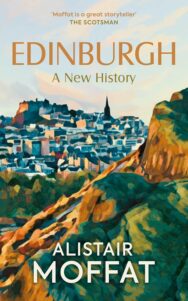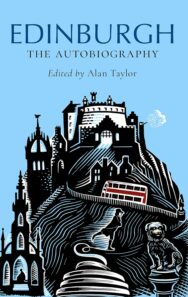‘It’s hard to imagine any city getting two such excellent books about it at the same time, and they complement each other perfectly.’
2024 marks 900 years since Edinburgh was first named and recorded in a letter by King David I, and to celebrate the occasion a number of excellent books on Auld Reekie’s history have been published. In his latest review, David Robinson compares two of these, their contrasting approaches, and the storied city they mythologise.
Edinburgh: The Autobiography
Published by Birlinn Ltd
Edited by Alan Taylor
Edinburgh: A New History
Published by Birlinn Ltd
By Alistair Moffat
Of the making of books about Edinburgh there is no end, and certainly not in its 900th year. Yet Alan Taylor’s Edinburgh: The Autobiography and Alistair Moffat’s Edinburgh: A New History offer pleasingly different takes on the city’s past.
Moffat is, as The Scotsman describes him on his book’s front cover, ‘a great storyteller’. You can see that right at the very start of the book. Chapter One, ‘Royal David’s City’, opens like this:
‘Nine centuries ago, a scribe sat down at his writing board on a summer’s day, and with a knife sharpened a quill into a nib. Having dipped it into ink made with oak gall, he began to write history…’
Some historians might huff and puff at a paragraph like that. They wouldn’t dare to presume that the scribe sat down to write or that he didn’t already have sharpened quills. And they certainly wouldn’t call that chapter ‘Royal David’s City’ because, well, Edinburgh certainly wasn’t, not then, on 17 July 1124, when a letter from King David I to the bishop of St Andrews mentions a house plot in Edinburgh which he has gifted to the priory of Dunfermline.
Yet here, in Latin legalese about a transfer of land ownership in a small town nowhere near as important as say, Berwick, is where Scotland’s future capital first enters the history books. The land itself was in burgo meo de Edensburg: in my town of Edinburgh. A trained medievalist, Moffat knows not only about the oak gall ink but also, presumably, how tedious medieval history can be when written by academics without imagination, who glory in irrelevant details, are incapable of synthesis, and don’t give a damn about the general reader.
His book is the opposite of that. Each of his 50 chapters is only about four pages long, flannel-free and engrossing. And if, as we range across the centuries, the effect on the reader is akin to that of someone looking at the Great Tapestry of Scotland – each panel a clearly defined topic, with fascinating detail, and storytelling skill – we shouldn’t be too surprised. Moffat selected the subject matter and wrote the text for that project too.
Inevitably, for at least the first half of Edinburgh’s 900 years, the narrative historian has the advantage over the anthologist attempting, as Alan Taylor does, to tell the city’s story through the words of those who were there at the time. Instead, Moffat can use a whole battery of sources to reach back to prehistory to speculate about the first inhabitants of the area and the Romans’ (probable) pontoon bridge across the Forth at Stirling, moving on to the building of Edinburgh Castle and the boom times that followed the loss of Berwick to the English.
While most civic histories are little more than a Gradgrindian trudge, Moffat writes with flair and imagination. He can convey both the revolutionary excitement of the Covenanters and the impact of Leslie’s arrival in Leith in 1638 (‘Suddenly the National Covenant became much more than pious words. Christ’s Kingdom of Scotland had an army’) and its antithesis, as here with the 1746 burning of the clan banners captured at Culloden with a pithiness and panache Macaulay himself would have found hard to beat:
‘At the Mercat Cross, the hangman burnt the silk banners of the Highland army, and as their smoke floated above the rooftops of the old town, an older vision of Scotland began to disappear.’
By now, though, the Enlightenment is lighting up Taylor’s book too. Here is Boswell, escorting Johnson up the High Street at night and embarrassed by the stench (‘A zealous Scotsman would have wished Mr Johnson to be without one of his five senses upon this occasion’); Smollet on the aged golfers of Leith ‘who never went to bed without having each the best part of a gallon of claret in his belly’; or Scott emphasising how Burns’s eyes ‘literally glowed when he spoke with feeling or interest’.
Meanwhile, the New Town is being built. Sometimes, as Moffat points out, land ownership got in the way of symmetry, which is why North Bridge doesn’t run straight into St Andrews Square, as originally envisaged. Sometimes the planners just got it wrong, which is why there’s still that slight dogleg between the Mound and Hanover Street. The Mound itself, Taylor points out, quoting an 1805 source, seems to have arrived almost by accident; a shopkeeper on the Lawnmarket, not wanting the inconvenience of having to walk to the New Town over North Bridge, got some of his neighbours to lay stepping stones across the still swampy remains of the old Nor’ Loch, and then persuaded New Town builders to dump the earth there that they’d dug out for the foundations of their buildings – all (he’d done the maths) 1,305,780 cartloads of it.
Yet wrecking a city is just as easy as building one and as Taylor shows in a fine piece by George Rosie, the 1960s plan for a six-lane inner ring road wasn’t the only near-miss. As far back as 1849, the redoubtable Henry Cockburn pointed out a few other ‘ways of spoiling the Beauty of Edinburgh’ that had been seriously considered, building on the north side of Castle Hill, filling up Princes Street Gardens to the level of the street and putting houses on its south side among them. Lest we complacently assume that such planning horrors no longer happen, Taylor also includes Guardian architecture critic Oliver Wainwright’s assessment of the W Hotel (‘You can’t polish a turd, but you can clad it in bronze-coloured steel’).
Along with his wife, Rosemary Goring (Scotland: The Autobiography, Scotland: Her Story), Taylor has a formidable track record of putting together revelatory, thoughtful, and eclectic anthologies. Edinburgh: The Autobiography is no different, and fully lives up to his stated aim that each entry ‘should read well and add something vital to the tapestry of a place that never fails to bewitch’.
Some of the early entries self-select, like Knox writing up his meeting with Mary Queen of Scots, and obviously there has to be some Scott, Stevenson, and Spark (though his selection of a delightful 1970 essay on the theme of ‘Nevertheless’ was new to me). A good anthology also knows when to go deeper into a topic, as Taylor does with Paul H Scott’s account of overturning the closure of the Scottish National Portrait Gallery, Ian Fraser’s barely credible story of the excesses of the Fred Goodwin regime at RBS, and historian Angela McCarthy’s 2022 attack on the falsification of history in the plaque placed by the council on the monument to Henry Dundas in St Andrew Square – all quintessentially Edinburgh stushies.
I’ve lived in Edinburgh for most of my adult life but Taylor’s book told me much I didn’t know or had never thought about, like what the city must have been like in the Second World War when all its private gardens lost their railings to the war effort (Charlotte Square Gardens were, noted The Scotsman, ‘trodden at all angles, till in wet weather they were a sea of mud’. When I walked my children to school, I didn’t realise that I passed Colt Bridge, where the Hanoverian dragoons fled in 1745 on the approach of the Jacobite army. On the way to work, I’d pass the White Hart Inn in the Grassmarket. I knew Burns had stayed there, but not that Dorothy Wordsworth and her brother had done too. I’d also pass St Cuthbert’s church, and while I knew De Quincey was buried in its churchyard, I now no longer will be able to forget this assessment of him by Carlyle in a letter to his brother: ‘Poor little De Quincey! He is an innocent man; and, as you said, extremely washable away.’
It’s hard to imagine any city getting two such excellent books about it at the same time, and they complement each other perfectly. I’ll give the last word to Stevenson. It’s a short poem his wife found among his papers after his death, but I won’t tell you which of these two books I found it in. You’ll have to read both.
I saw rain falling and the rainbow drawn
On Lammermuir. Hearkening I heard again
In my precipitous city beaten bells
Winnow the keen sea wind. And here afar,
Intent on my own race and place I wrote.
Edinburgh: A New History by Alistair Moffat is published by Birlinn, priced £14.99
Edinburgh: The Autobiography by Alan Taylor is published by Birlinn, priced £20.
ALSO IN THIS ISSUE

 David Robinson Celebrates: Edinburgh’s 900th Birthday
David Robinson Celebrates: Edinburgh’s 900th Birthday
‘It’s hard to imagine any city getting two such excellent books about it at the same time, and they …














